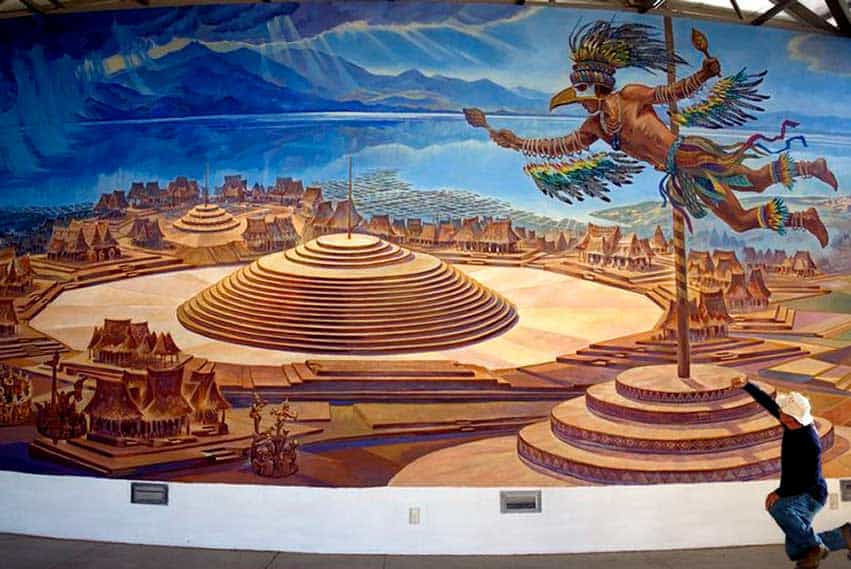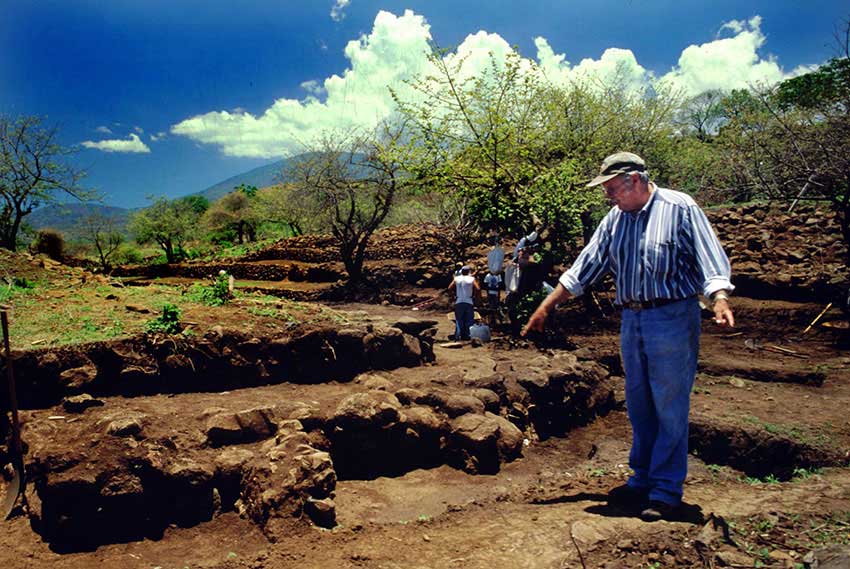Two thousand years ago, a unique society thrived in western Mexico. It appears they were the only people in history to base their public monuments on the geometry of concentric circles, and to this day their hundreds of circular pyramids still mark the territory of an empire bigger than Guatemala.
The capital of this ancient nation was Teuchitlán, “The Place of the First God,” located within the shadow of the Tequila Volcano, 40 kilometers (25 miles) west of Guadalajara, Mexico’s second-largest city.
Inhabitants of the modern-day Teuchitlán knew there was something special about a group of large mounds just over a kilometer north of town, but had no idea how important they once were. They called these mounds Los Guachimontones.
I paid my first visit to this site in 1985 before any sort of development had taken place. Upon reaching the edge of the little town of Teuchitlán, I stared in disbelief at the “road” leading to the Guachimontones. I was driving a Jeep, but that so-called road was such a mass of ruts and churned up rocks that I simply parked and went on foot.
All I could see were tall weeds and cornfields but, by good luck, I found a farmer out there who pointed to a hill covered with heavy brush. “That is a Guachimontón,” he said.

Just getting through the corn to the base of the Guachimontón was difficult enough, but now I had to push my way through thorn bushes, cacti and irritating nettles to finally reach the very top of the hill — which did appear to be man-made. “This is an unusually tall heap of rocks,” I thought, “but that’s all it is, just a heap of rocks.”
Without realizing it, I had drawn a conclusion similar to what many archaeologists of the time thought about the nature of ancient west Mexico and — like them — I couldn’t have been more mistaken.
Unknown to me, two local researchers, archaeologist Phil Weigand and his wife Acelia, an art historian, had looked beneath the surface at Teuchitlán and had discovered that the textbooks were wrong. An amazing civilization — unique in many ways — had once flourished in those weed-covered hills.
Twenty some years before my visit to the Guachimontones, Acelia Weigand happened to be visiting a natural spring located just east of Teuchitlán. “It was in 1962,” she says. “The kids were diving near a huge fig tree in a small, natural pool when I saw these shiny pieces of glass under the water. I told them to be careful because there were broken bottles down there and they could get cut.
“So the kids started pulling these shiny things out and they said, ‘No auntie, they’re not bottles, they’re knives!’ Well, all of them were long, sharp, prismatic blades of obsidian and I brought 13 of them back to our house in Etzatlán. But I couldn’t get Felipe to pay any attention to them for seven years. Seven years it took for me to lead him up to the obsidian workshop from which those blades had washed down to the swimming hole!”
This ancient obsidian workshop led the Weigands to the ruins of the pyramids now known as the Guachimontones. Phil Weigand later recalled: “I stood on the largest pyramid, looked around and thought, this is unexpected.”

It turned out to be an understatement. The Weigands set aside a summer to explore the pyramids they had found and ended up spending the next 29 years documenting a complex, highly organized society which had begun in western Mexico in 1000 BC and had reached its apogee around 200 AD.
I had no clue what the Guachimontones represented until one day in 1997, when I heard rumors about an American archaeologist living in the town of Etzatlán, 26 kilometers northwest of Teuchitlán. Tracking down a foreigner in a small Mexican town is easy and this is how I first met the Weigands.
One of the many endearing characteristics of Phil Weigand was his total lack of pretentiousness and his willingness to share his discoveries — at length, I might add — with anyone who would listen, and I do mean anyone, even the humblest rancher or laborer.
“Look at these clay models of people gathered around the Guachimontones,” he said. “I’ve just had them made. Each one is a faithful copy of a 2,000-year-old original found right here in this part of Jalisco. Aren’t they amazing?”
“Amazing” doesn’t do justice to those clay models. They are full of life. We see dozens of people socializing, chatting and jostling one another or perhaps linked arm in arm, performing the cadena (chain dance), while listening to groups of musicians. Around this walkway, on evenly spaced, terraced platforms, the local VIPs gazed out the doorways of buildings that to western eyes might look typically Chinese.
These structures had tall, pointy, gabled roofs which, along with their wattle-and-daub walls, were carefully plastered and beautifully painted in bright colors. The VIPs chatted with the people in the milling crowd, perhaps discussing the latest score of the ball game taking place in the court located alongside the largest pyramid. Directly to the north, a huge crowd of onlookers may have watched the events from a steep, terraced hillside.
Everyone, of course, was anxiously waiting for the main event of the day to begin. A sturdy pole had been set in the exact center of each steep pyramid. No one today knows exactly what its function was. The clay models show a “flier” balanced on top of the pole, probably representing Ehécatl, the Bird Man and, as the clay models show us, a crowd of people pushing on the pole caused him to “fly.”
It is also possible that ropes were wound around the pole, as is still done today in Veracruz, and that fliers tied to the ropes and bedecked with feathers swooped through the air in ever-widening circles, soaring up and down like graceful birds, finally to land on the circular walkway around the pyramid.
This, however, is pure speculation on my part, as no archaeological proof has yet been found to back up the idea that the ritual of voladores originated here.
The size and proportions of the rings around the mound followed a deliberately chosen geometrical formula, and the diameter of the pyramid was always 2.5 times the width of the walkway. These proportions form the basis for Teuchitlán’s formal circular architecture which is unique not only in Mesoamerica, but in the entire world. Nearly 200 complexes employing this architectural style have been found in western Mexico, making it easy for archaeologists to trace the limits of Teuchitlán’s influence.
No one knows what these people called themselves. What we do know is that they revered Ehecatl, “the First God, who was known as the Night Wind and portrayed as the Bird Man, covered with feathers.” Ehecatl apparently didn’t need human sacrifice to satisfy his ego. Perhaps because of this, the people of the Teuchitlán tradition seem to have been peaceful souls in comparison with the Aztecs, who came much later.
The bright blaze of the Teuchitlán civilization began to dim around the year 450 AD for reasons so far unknown. Archaeologists tell us that a day came when every building around the circular pyramids was burned to the ground. At the same time, new organizational and political systems had sprung into existence and the ritual of the Bird Man simply disappeared. These changes were expressed architecturally in the form of rectangular buildings. Gone were the circular pyramids — forever.
[soliloquy id="70805"]
For a while it was thought that the Teuchitlán people had simply vanished around 450 AD, but when the foundations were dug for a museum, now called the Phil Weigand Interpretive Center, numerous proofs were uncovered showing that Teuchitlán had been inhabited continuously for 2,000 years, from the pre-classical period right through to the post-classical. The enigma of this curious and industrious civilization is today inspiring a new generation of archaeologists to carry on the studies begun by the Weigands and to dig even deeper into the fascinating mystery of the ancient people of Teuchitlán.
More than 150,000 people from all over the world visit the Guachimontones ruins and museum every year. The site is open Tuesdays to Sundays from 9 to 5 and there is no admission charge on Tuesdays. An English-Spanish guide to the Guachimontones is available at the museum and can be ordered online.
The writer has lived near Guadalajara, Jalisco, for more than 30 years and is the author of A Guide to West Mexico’s Guachimontones and Surrounding Area and co-author of Outdoors in Western Mexico. More of his writing can be found on his website.
